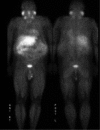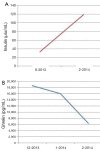Transition of a pancreatic neuroendocrine tumor from ghrelinoma to insulinoma: a case report
- PMID: 25830049
- PMCID: PMC4311091
- DOI: 10.3978/j.issn.2078-6891.2014.113
Transition of a pancreatic neuroendocrine tumor from ghrelinoma to insulinoma: a case report
Abstract
Pancreatic neuroendocrine tumors (PNETs) are rare with an incidence of 1 in 100,000 populations. PNETs can present either as a functional or non-functional tumor. In functional tumors the symptoms are a result of hormones such as insulin, gastrin, glucagon and vasoactive intestinal peptide (VIP) or others. Ghrelin is a 28 amino acid peptide discovered in 1999 and is thought to be involved in various physiologic and pathologic processes. Due to relatively recent discovery of this hormone, its functions in normal homeostasis and its association with various pathologic processes are still being uncovered. PNETs are a rare entity and the natural history of disease is not well known. We have presented a first ever case of metastatic PNET which presented as a ghrelinoma and later transformed into a symptomatic insulinoma. This case gives us a glimpse into an unusual variant of metastatic PNET. It also tells us that change in functional tumor biology can sometime be more morbid than the metastatic disease itself.
Keywords: Pancreatic neuroendocrine tumor (PNET); ghrelinoma; insulinoma.
Figures
Similar articles
-
Metachronous hormonal syndromes in patients with pancreatic neuroendocrine tumors: a case-series study.Ann Intern Med. 2015 May 19;162(10):682-9. doi: 10.7326/M14-2132. Ann Intern Med. 2015. PMID: 25984844
-
Pancreatic neuroendocrine tumors.Endocr Res. 2011;36(1):35-43. doi: 10.3109/07435800.2010.525085. Endocr Res. 2011. PMID: 21226566 Review.
-
Symptomatic and Radiological Response to 177Lu-DOTATATE for the Treatment of Functioning Pancreatic Neuroendocrine Tumors.J Clin Endocrinol Metab. 2019 Apr 1;104(4):1336-1344. doi: 10.1210/jc.2018-01991. J Clin Endocrinol Metab. 2019. PMID: 30566620
-
Utility of chromogranin A, pancreatic polypeptide, glucagon and gastrin in the diagnosis and follow-up of pancreatic neuroendocrine tumours in multiple endocrine neoplasia type 1 patients.Clin Endocrinol (Oxf). 2016 Sep;85(3):400-7. doi: 10.1111/cen.13119. Epub 2016 Jun 30. Clin Endocrinol (Oxf). 2016. PMID: 27256431 Free PMC article.
-
Determinants of surgical resection for pancreatic neuroendocrine tumors.J Hepatobiliary Pancreat Sci. 2015 Aug;22(8):610-7. doi: 10.1002/jhbp.224. Epub 2015 Mar 13. J Hepatobiliary Pancreat Sci. 2015. PMID: 25773163 Review.
Cited by
-
Insulinoma after sleeve gastrectomy: A case report.World J Clin Cases. 2022 Jun 26;10(18):6227-6233. doi: 10.12998/wjcc.v10.i18.6227. World J Clin Cases. 2022. PMID: 35949856 Free PMC article.
-
Adipokines in Neuroendocrine Tumors: An Evaluation of the Serum Levels of Ghrelin and Leptin.Int J Mol Sci. 2024 Sep 11;25(18):9820. doi: 10.3390/ijms25189820. Int J Mol Sci. 2024. PMID: 39337308 Free PMC article.
-
Multilayered heterogeneity as an intrinsic hallmark of neuroendocrine tumors.Rev Endocr Metab Disord. 2018 Jun;19(2):179-192. doi: 10.1007/s11154-018-9465-0. Rev Endocr Metab Disord. 2018. PMID: 30293213 Review.
References
-
- Klöppel G, Perren A, Heitz PU. The gastroenteropancreatic neuroendocrine cell system and its tumors: the WHO classification. Ann N Y Acad Sci 2004;1014:13-27. - PubMed
LinkOut - more resources
Full Text Sources



